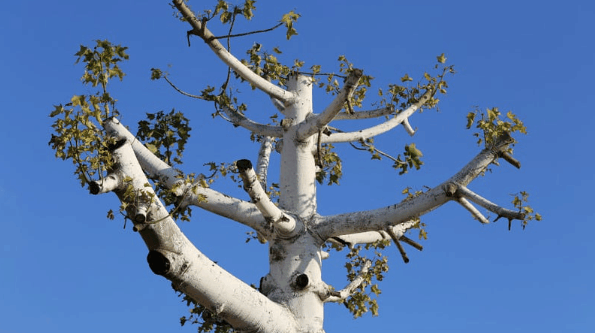
In this Tree Surgeon Pro blog, we're putting a couple of pruning techniques under the microscope to gain a better understanding of each one.
While pruning is a great idea (we'll explain why shortly), it must be performed correctly to get the best results and avoid damaging the tree, perhaps fatally.
Today, we're looking at tree topping vs. pollarding to enlighten you as to the differences and to weigh up which is best. This blog is particularly important, as the two terms are sometimes used interchangeably, which is confusing.
So, without further delay, let's get started...
Topping a tree involves cutting off a large proportion of the upper branches from the tree's canopy or crown. This is usually done to reduce the tree's height, typically to address safety concerns, such as preventing branches from affecting power lines or nearby roofs.
In all honesty, it's a pretty controversial pruning technique that draws criticism from most tree specialists, including all good tree surgeons and arborists. And it has to be said, the Tree Surgeon Pro team are not keen on this pruning method!
So, what's wrong with tree topping and why should you avoid it?
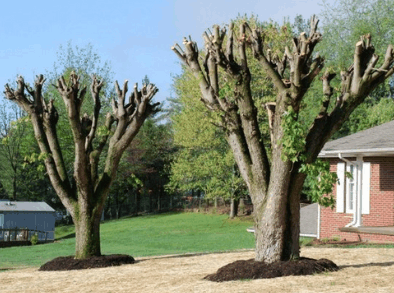
Tree topping is also known as hat racking due to the shape of the tree after the process is complete - the tree's crown now resembles a hat rack as only the lateral branches remain.
This harmful practice drastically reduces the amount of foliage, reducing the tree's ability to produce food through photosynthesis, which puts the tree under enormous stress. The tree's response is to put out suckers or watersprouts from the pruning cuts, and these fast-growing shoots try to compensate for the loss of leaves.
Sadly, this uses up so much stored energy that the tree is left weakened and vulnerable, often resulting in its death.
Hacking away the upper branches dramatically changes the tree's natural shape, making it look stunted and disfigured. In addition, the mass of watersprouts gives the tree a messy, chaotic appearance that detracts from its natural beauty.
If you were topping a tree to make it look better, this is one of the worst options! Many tree species take decades to create a balanced and graceful shape, and topped trees lack this aesthetic appeal, spoiling years of natural growth.
The new shoots that emerge after a tree has been topped are poorly secured to the main limbs, making them structurally weak. Because they lack a strong attachment point, these suckers are significantly more prone to snapping off during storms or high winds. While topping may seem like a way to make a tree safer, it actually increases the likelihood of future damage, creating hazardous conditions rather than preventing them!
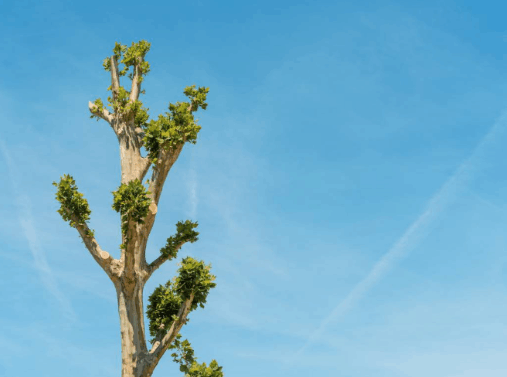
Topping results in large, open wounds that trees struggle to heal effectively. These large wounds serve as entry points for fungal infections, rot, and insect infestations, making the tree highly vulnerable to further damage. Without the ability to properly seal these cuts, the tree’s internal structure begins to deteriorate. In many instances, the tree is unable to recover fully, either weakening progressively over time or ultimately succumbing to decay and dying altogether.
While tree topping is never ideal, there is a chance that a qualified arborist can come to the rescue, using a technique called crown restoration.
First, the tree will be examined to identify any shoots that have grown into new branches. Weaker, dead or diseased branches will be selectively pruned, leaving the stronger ones to thrive. The crown will be gradually reshaped to create a balanced, healthy and stable canopy without causing further stress to the tree.
Be warned, though - this process can take a few years and requires patience and a lot of care!
Pollarding is a traditional pruning technique to control tree growth, used widely on street trees in urban environments and also in rural areas, particularly on willows. This method only works for certain tree species aside from willows, typically on broadleaf deciduous species, such as ash, elm, London plane, beech, oak, hornbeam and lime trees.
When the tree is young, the branches are cut back to a specific point to form a pollard head. The tree responds by pushing out new growth from these points, creating a distinctive, dense head of foliage. This process is repeated every few years (usually much sooner in the case of willow) to control tree size and shape.
This is handy as it provides a more controlled method of taming large trees in urban areas, encouraging dense regrowth and healthy trees with a compact canopy that reduces the amount of shade cast. This also reduces the risk of damage due to branch failure, keeping the tree to a manageable size.
Bear in mind, though, that this works best on young trees that are regularly pollarded over the years - suddenly pollarding older trees can send them into severe shock, with the same results as tree topping.
Unlike tree topping, pollarding is great for preventing branches from growing out of control and for increasing the tree's lifespan.
Pollarded trees can look similar to topped trees, hence the confusion, but they can be identified by checking the cut points:
In our pollarding vs tree topping quest, it's clear that we're favouring pollarding, and we make no secret of this fact. Nevertheless, even pollarding must be handled properly, or it could compromise the tree's structure and affect its long term health.
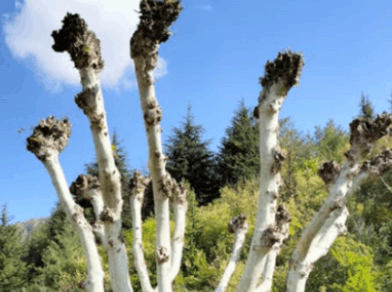
Regular pruning is a must for tree health and longevity, so it's vital to use proper pruning techniques to get the desired results.
As a professional tree care company, we're frequently asked about pruning and whether it's necessary. The honest answer is that it isn't at all necessary. After all, trees in the wild seem to cope pretty well without it, on the whole!
However, when trees and humans are in close proximity with each other, the potential risks are high; Tree branches, and even entire trees, can fall, causing damage, injury and even death. So, we need to keep them in check by pruning them well. Using proper pruning methods also has another advantage in that it reduces the risk of disease and fungal decay, meaning that your trees live longer.
Finally, properly pruned trees have more visual appeal, enhancing our outdoor spaces and adding much-needed greenery to our town and city streets.
We've highlighted the facts above, and we've been very clear about the negative results associated with tree topping. In addition, while pollarding is beneficial, it has to be performed correctly to get the best outcome.
But before you head out to the shed to grab your pruning shears, lopping saw or chainsaw, take a moment to pause and consider calling an expert.
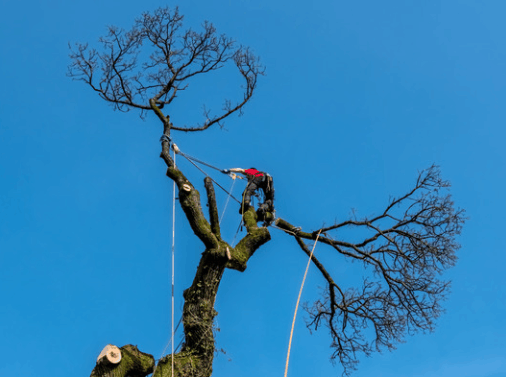
Tree work can be exceptionally hazardous, especially when working on tall trees. Specific tree species can also be difficult to work on, depending on whether they are hardwood or softwood, and you may be working in a limited space, probably at height.
At Tree Surgeon Pro, our fully trained and qualified tree surgeons are prepared for every eventuality and equipped with all the safety gear necessary to get the job done with minimal fuss while reducing the risks to virtually zero.
They also know the best times to prune, as well as when to avoid removing branches. Each tree is carefully assessed for any risks, and any weak, diseased or dead branches are identified before work proceeds—this level of insight is what sets a professional tree surgeon or arborist apart.
So, when you need tree work of any kind, whether it's pollarding, crown reduction, crown lifting, tree removal, or even stump grinding, our dedicated team of professionals is ready to take up the challenge.
Also, if your trees have faced the horror of being topped and are in need of TLC to restore them, we are happy to check them and see if they can be rescued!
Contact our friendly team today for advice on all things tree-related and to discover our range of services to keep your trees safe, happy and healthy.